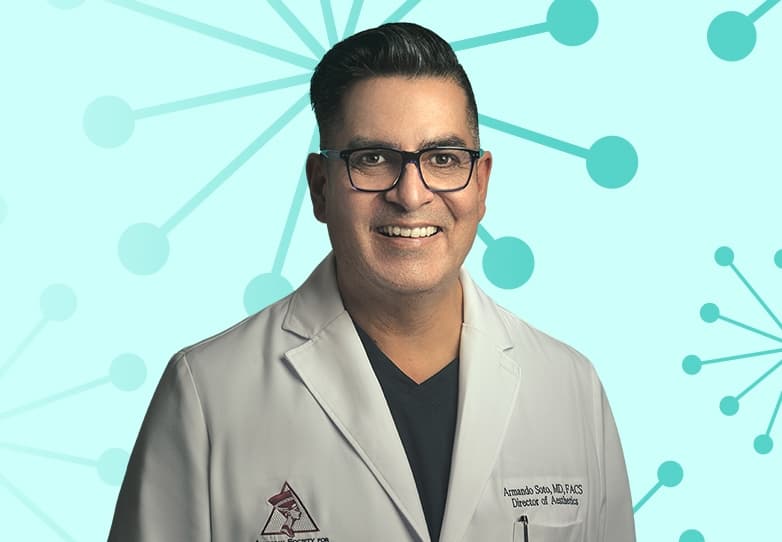Aesthetic Enhancements Plastic Surgery & Laser Center: Armando Soto, MD
7009 Dr Phillips Blvd #100
Orlando, FL 32819
Phone: (407) 218-4550
Fax: (407) 218-4551
Monday–Friday: 9 a.m.–5 p.m.
Calf Implants
*Includes surgical, anesthesia, and OR fees, implants, and post-surgical garments
Board-certified Plastic Surgeon Dr. Armando Soto offers several male enhancement procedures at his plastic surgery practice, including calf implant surgery. While women can also get calf implant surgery, it is more popular in men to create a more proportionate calf appearance. In men, this procedure is used to enhance fullness in the lower leg and to emphasize the muscle bellies. Calf augmentation is ideal for individuals who desire shapelier calves or stronger muscle definition in their lower legs.
Serving Calf Implant Patients Throughout the Orlando Metro Area
At Aesthetic Enhancements Plastic Surgery, Dr. Soto consults with patients from all over the Orlando metro region and across Florida to determine which size and shape silicone calf implants will meet their goals. Dr. Soto seeks to create results that produce a smooth and natural contour in the lower leg, and he regularly sees patients from communities such as:
- Winter Park
- Winter Garden
- Kissimmee
- Sanford
Surgical Technique
During calf augmentation surgery, the legs are measured to determine the suitable size and shape of implant to use. The incision is then created in the natural line of the fascia, the fibrous tissue that covers the outer muscle. A special instrument is used to create a “pocket” between the fascia and the muscle, which is big enough for the implant insertion. Implants are typically inserted into the muscle, and the area is reshaped until the desired size is achieved. Because the muscle covers the actual silicone device, the calf looks and feels like real muscle. The wounds are then closed with stitches and once they dissolve, scarring is minimal due to the discreet location of the incision.
During/After Surgery
Calf augmentation surgery normally takes about an hour per leg and is performed as an outpatient procedure under general anesthesia or IV sedation. After surgery, especially during the first week, crutches are required until the patient can stand and walk slowly. When lying down, legs should be elevated in order to reduce the swelling. A stretching regime will be prescribed that helps the legs get adapted to having the implants in place. Once the first week is up, the patient can walk longer and greater distances. The results are a shapelier, curvier lower leg that can last for many years.
Dr. Armando Soto
Dr. Soto is a board-certified plastic surgeon who brings an exceptional level of attention, skill, and integrity to every patient and procedure. For more than 15 years, he has helped Orlando women and men look and feel fabulous using innovative yet proven surgical and nonsurgical options. As a well-respected plastic surgeon, Dr. Soto is a member of leading professional associations, including the American Society of Plastic Surgeons (ASPS) and The Aesthetic Society.
Meet Dr. SotoCredentials You Can Trust

Calf Augmentation FAQS
Only Aesthetic?
Calf augmentation surgery is not confined to aesthetic purposes only. There are several illnesses or diseases that this procedure can help to correct a visual defect in the lower leg. Specifically, diseases such as Poliomyelitis and Spina Bifida can lead to a visible deformity. In addition, clubfoot where the heels and toes turn inward, as well as bow-legged conditions can also be corrected with implants.
Are Scars Noticeable?
The placement of the incision when it comes to cosmetic surgery (in most cases) is always along natural folds and creases of the area being treated so it can be easily concealed. For calf augmentation, the incision is located either behind the knee or under the front knee. When the scar heals, this strategic positioning will conceal the scar making it difficult to see.
How Long Will They Last?
The results from calf augmentation, just like with any other cosmetic surgery that uses implants, can last for approximately 10-15 years. However, once the patient ages, a shapelier calf may no longer be desired if it does not remain proportionate with the rest of the body. In some cases, patients can opt to have the implant removed if they wish. However, they are considered permanent until that decision is made.
